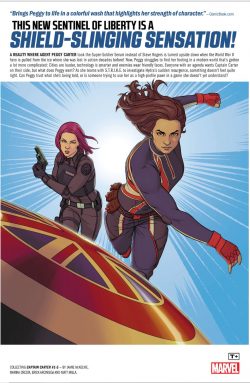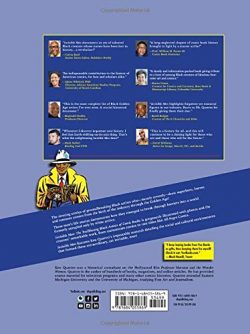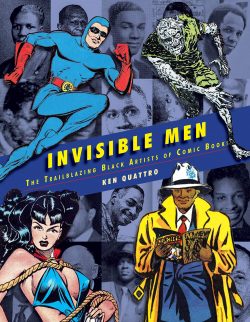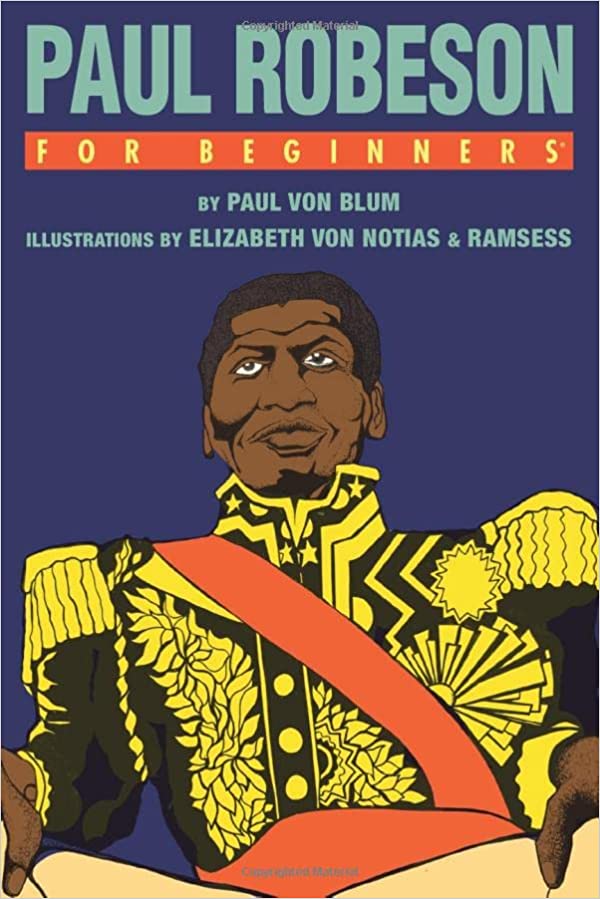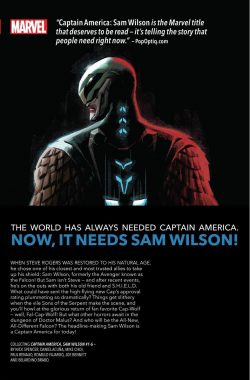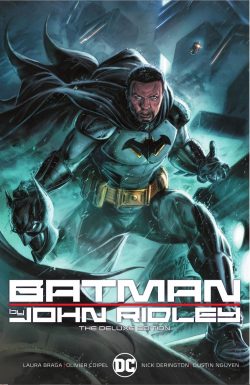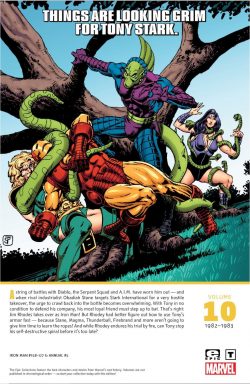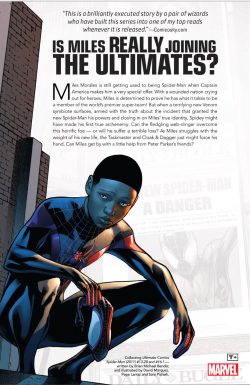
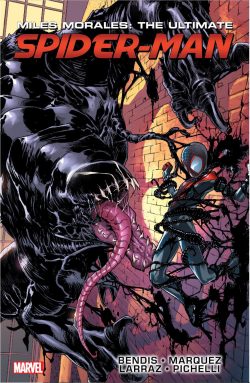
By Brian Michael Bendis, David Marquez, Pepe Larraz, Sarah Pichelli & various (MARVEL)
ISBN: 978-0-7851-9779-9 (TPB/digital edition)
After Marvel’s financial and creative problems in the late 1990s, the company came back swinging. A key new concept involved remodelling and modernising their core pantheon for the new youth culture. The Ultimate imprint abandoned the monumental, slavish continuity which had always been Marvel’s greatest asset, giving its revamped players a separate reality to play in. Varying degrees of radical makeover appealed to a contemporary 21st century audience and proved a godsend as base material for the new Marvel Cinematic Universe.
Peter Parker was once again reduced to a callow, nerdy high-school geek, brilliant but perpetually bullied by his physical superiors. There were even fresh, fashionable, more scientifically feasible rationales for the fore-destined spider bite which imparted those patented, impossible arachnoid abilities.
His uncle Ben Parker still died because of the lad’s lack of responsibility. The Daily Bugle was still there, as was bombastically outrageous J. Jonah Jameson. Now, however, in a more cynical, litigious world, well-used to cover-ups and conspiracy theories, arch-foe Norman Osborn – a corrupt, ruthless billionaire businessman – was behind everything.
Any gesture towards the faux-realism of traditional superhero fare was surrendered to the tried-and-tested soap-opera melodrama which inevitably links all characters together in invisible threads of karmic coincidence and familial consanguinity but, to be honest, it seldom hurt the narrative. After all, as long as internal logic isn’t contravened, subplots don’t have to make sense to be entertaining.
After a short, spectacularly impressive career, original outsider Peter finally gained a measure of acceptance and was hailed a hero when the Ultimate Comics Spider-Man valiantly and very publicly met his end at Osborn’s hands during a catastrophic super-villain showdown…
Soon after he died, a new champion cast in his image arose to carry on the fight…
Written throughout by Brian Michael Bendis, this collection concerns controversial new kid Miles Morales in material published before mega-crossover events Time Runs Out and Secret Wars merged select remnants of the Ultimate Universe with mainstream Marvel continuity. It specifically re-presents Ultimate Comics Spider-Man #13-28 (October 2012 -December 2013) and sidebar release Ultimate Comics Spider-Man #16.1.
In the aftermath of Parker’s last moments, African American/Latino child prodigy Miles was revealed to have gained similar powers. The freshly empowered 13-year-old quickly adjusted to his astounding new physical abilities whilst painfully discovering the daily costs of living a life of lies and how an inescapable sense of responsibility is the worst of all burdens…
The revelations here begin by spinning back to the relatively recent past when industrialist Osborn repeated the genetic experiment which first bestowed incredible powers on Parker via the accidental bite of artificially mutated spider. Unfortunately, the deranged mastermind failed to anticipate a burglar waltzing in and carrying off his test animal as part of his haul…
After grade-schooler Miles got into prestigious, life-changing Brooklyn Visions Academy Boarding School by the most callous of chances, the boy reluctantly accepted life is pretty much a crap-shoot… and unfair to boot.
Feeling guilty about his unjust success and sorry for the 697 other poor kids who didn’t get his lucky break, he set off to visit his uncle Aaron. The visit had to be secret since his uncle is a “bad influence” …and a career criminal …
Whilst there, a huge spider with a number on its back bit Miles and he began to feel very odd. He also started fading from sight…
Suddenly super-fast and strong, able to leap huge distances and become invisible, Miles rushed to consult geeky pal Ganke, a prodigious nerd already attending Brooklyn Visions. Applying “scientific testing”, the self-proclaimed hero-expert confirmed Miles was now similar to Spider-Man but could also deliver shocking, destructive blasts through his hands.
When Morales headed home, Ganke continued researching and deduced the connection to the wallcrawler, and began pushing his pal into being a costumed crusader just like him. Sadly, after Miles intervened during a tenement fire – and saved a mother and baby – shock set in and he swore never to use his powers again…
Time passed: Miles and Ganke had been dormmates at the Academy for nearly a year when a major metahuman clash rocked the city. Troubled, Miles headed out and witnessed Spider-Man’s murder. Seeing a brave man perish so nobly, he was again consumed by guilt: if he had used his own powers when they first manifested, Morales might have been able to help save a true hero…
As part of the crowds attending Peter Parker’s memorial, Miles and Ganke talked to another mourner Gwen Stacy actually knew Parker and offered life-changing insights to the grieving boys …and a phrase which altered the course of Miles’ life: “with great power comes great responsibility”…
This compilation follows Miles and his close circle of confidantes from crushing but commonplace tragedy and peril into total chaos and carnage as America succumbs to a second Civil War following shattering global crises. In the Land of the Free and Vanguard of Democracy ineffectual leadership and rogue elements in power converge and whole swathes of ordinary Americans secede from the Union…
Now a day resident at Brooklyn Visions Academy Boarding School, Miles spends only weekends at home and is coming to terms with some unpleasant truths. Foremost is that he has secrets to keep from his parents, but also poisoning the air is the fact that his father used to be a street-thug and now passionately hates costumed heroes like the new Spider-Man.
Uncle Aaron – AKA costumed super-thief The Prowler – has been secretly grooming Miles ever since some of his loot bit the kid, making him a super-strong and fast potential asset who can walk up walls, turn invisible and deliver a devastating venom charge through his hands… Illustrated by David Marquez, the action commences as the patiently manipulative creep tricks Miles into attacking Mexican gang-lord and prospective new Kingpin of Crime the Scorpion. However, during a blistering raid on the gangster’s plush new club, in the heat of battle, the novice wall-crawler at last realises Aaron isn’t reforming or making amends, but simply taking out opposition for his own attempt to take over New York’s underworld…
Events come to a tragic head when Aaron accosts Miles at school: blackmailing him by threatening to tell his father all about Spider-Man. It goes badly and results in a devastating showdown. Hardened by years of criminal experience and equipped with an ingenious arsenal of gadgets he murdered underworld armourer The Tinkerer for, Aaron goes crazy, determined to end his rebellious nephew. The fight inevitably escalates, endangering a busload of civilians who all see the neophyte wall-crawler first save them before apparently killing the Prowler in a horrific explosion…
Meanwhile in the wider world: In the wake of the global inundation, ongoing internecine strife amongst the covert ops community, and deadly brushfire wars all over the planet, ousted spymaster Nick Fury regained control of S.H.I.E.L.D.’s army of agents and officially-sanctioned super-squad The Ultimates as well as clandestine task-force The Avengers, just as civilisation started coming apart at the seams…
Metahumans had become governments’ prime and preferred “Weapons of Mass Destruction” and personal superpowers were the focus of a terrifying global arms race. In Asia, emergent federated nation SEAR dissolved into bloody conflict soon after developing a serum that randomly sparked fantastic abilities in ordinary humans. The plan had been to win the human arms race but events quickly overtook the leadership when they tried to further tip the scales by simultaneously releasing a virus to neutralise those genes that triggered natural mutations.
With a plague preventing the birth of any more mutants and lab-produced metahumans roaming the streets, SEAR collapsed from internal dissent and open warfare.
From the conflict, dual metahuman nations were established and both Celestials and Eternals began offering super-powers to anybody brave or greedy enough to want them…
When WWII super soldier Captain America vanished, the gods of Asgard, who had been dragged from their heavenly halls and marooned on Earth, were slaughtered by a new fantastic race called the Children of Tomorrow, whose appearance presaged a deadly fight for control of Earth by The Maker – actually disgraced former superhero Reed Richards. The deranged genius had created a high-tech Dome where enhanced time, forced evolution and ruthless scientific augmentation enabled inhabitants to hyper-develop thousands of years in the space of days.
War against the Dome involved most of Earth’s metahumans, allowing corrupt S.H.I.E.L.D. Agent Flumm to oust Fury and coerce Bruce Banner into attacking the future city. The Hulk’s assault went tragically wrong, however, as The Maker convinced the man-monster to switch allegiances. The American President, distracted by one too many crises, allowed genocidal anti-mutant activists to turn the southwest into their own hunting preserve, inspired by the hate-filled preaching of Reverend William Stryker…
With Sentinels and militias controlling Arizona, New Mexico, Utah and Oklahoma – and carrying out a successful campaign of extermination – Texas declared its independence. Many other States saw rich opportunity and followed suit, even as the President launched the nation’s entire nuclear arsenal at the ever-evolving Dome…
The nuclear fusillade and a metahuman attack could not obliterate the Dome, but the component-intelligence of the living city was badly damaged. In retaliation, Richards unleashed the Hulk and a very special Child of Tomorrow he had cultured without the knowledge of the Dome’s hive-mind. The child detonated with nuclear force in the Capitol, utterly eradicating Washington DC and the American government. Although the Dome was no longer an urgent threat, President Howard – who only the previous day was the earnest but under-qualified new Secretary of Energy – was in well in over his head.
With a nuclear-armed Texas threatening the Union, Sentinels rampaging through the southwest and militant local militias sparking rebellions all over the country, President Howard declared martial law as the nation splintered around him. Flumm was also rapidly losing his grip and could not handle more bad news when word arrived that Captain America had returned from his self-imposed exile…
For fuller comprehension readers are strongly advised to consult companion Ultimate Comics series X-Men and The Ultimates. These will greatly enhance understanding of the parlous state of this alternate universe in its darkest hours…
With the USA ripped apart by a rash of local rebellions and actual State secessions, this binary publishing event – designed to create a jumping-on point for even newer readers – opened for Miles with ‘Divided We Fall’ as the Sentinel of Liberty stops in New York long enough to learn that there’s a new – barely teenaged – wallcrawler.
Keenly aware that the previous Spider-Man died saving him, Captain America overreacts and hunts down Miles, just as the boy is trying to deal with the flak and aftermath of Uncle Aarons death and accusatory final words. Troubled that he may indeed be “just like him” Miles faces hostile media bombardment after being accused of murder – and is unsure whether or not he’s actually guilty as charged…
A lunatic battle against opportunist thief Batroc the Leaper provides cathartic relief for the troubled boy but things get complicated all over again after during a shocking, surprise confrontation with May Parker, Gwen Stacy and Mary Jane Watson changes Miles’ life forever.
Peter Parker’s loved ones have been following the new boy’s short career and now they give the poor kid their full support and approval – as well as the original martyr’s web-shooters and secret formula. At last Spider-Man will be a web-spinner again… unless the furiously outraged and indignant America shuts him down for good…
The clash of wills is only resolved when the rampaging Rhino breaks loose, and Spidey saves the day, forcing the Star Spangled Avenger to compromise and grudgingly permit the kid to carry on… under strict adult supervision and training.
The saga culminates with 4-chapter epic ‘United We Stand’ (illustrated by Marquez & Pepe Larraz) as Civil War explodes west of the Rocky Mountains. In locked-down New York, Spider-Man gets a huge boost when he learns from the cops that he wasn’t responsible for the Prowler’s death. However, even as the ebullient arachnid rushes to enlist in the Ultimates’ push to retake America, his own strait-laced father is arrested for breaking curfew. The horrible ramifications of this misunderstanding will bring the loving, concerned parent to the edge of insanity…
Cap is still trying to make his exuberant underage volunteer go home when a devastating attack by Hydra-backed separatists plunges Miles into the thick of the action. Reassured by the boy’s conviction if not capability, the Sentinel of Liberty at last welcomes the new kid to the team.
Events quickly overtake everybody, however, as President Howard is informed by seditious elements of his own government that he has no official mandate to rule. In the middle of the war, the overburdened leader calls an emergency Recall Election…
With the plebiscite campaign and daily battles on every news channel, the tirelessly combative Captain America is elected to the battered nation’s highest office. He was utterly unaware that he was a candidate, but without breaking step, the hero graciously accepts before getting back to the job of re-Uniting the States…
With President America in the vanguard – as usual – the scene shifts to Casper, Wyoming for the final battle against a million-strong militia manipulated by the secret magical mastermind behind the entire crisis. Sadly, Spider-Man is elsewhere, lost and near death…
The boy had partnered with constantly objecting Spider-Woman Jessica Drew – who obnoxiously insisted he was too young to be there at all. Far worse than his wounds and prospects is Miles’ suspicion that she might have been right all along…
Fighting was fast and furious, and after a spectacular skirmish the Amazing Arachnid saved the President’s life but was knocked unconscious. He awoke wounded and lost in the flat vastness of Wisconsin with a Hydra-controlled Giant-Woman trying to squash him like a bug.
Nobody was there to witness his most impressive victory ever, but even though he was feted all the way back to New York as the victorious Union forces began the long, tedious job of consolidating power whilst attempting Reconstruction and Reconciliation, Miles had bigger problems.
As the juvenile wallcrawler recovered in the aftermath of the second War Between the States, Miles now had even bigger secrets and a far more complex double-life to keep from his folks.
That internecine conflict almost destroyed the Republic but has left the traumatised public in no mood to tolerate mysteries or put up with unexplained, potentially dangerous characters and vigilantes. Moreover, something had happened in his absence and his father was acting really, really strangely…
A new era dawns in jump-on tale ‘Point One’ (illustrated by David Marquez from Ultimate Comics Spider-Man #16.1) as unscrupulous reporter Betty Brant uses her considerable investigative skills to establish a link between The Prowler, the new Spider-Man, the genetic experiments of Norman Osborn and a guy named Morales…
As she digs deeper, following the brief career of the new hero, Brant not only uncovers the remains of the genegineered spider that transformed Miles, but also learns far more than she should have from disgraced Oscorp biochemist Dr. Conrad Marcus, as well as engendering the unwelcome interest of scientific monolith Roxxon Industries and a brutal, relentless shape-shifting monstrosity…
Illustrated by Sara Pichelli, 4-part epic ‘Venom War’ opens in the days of reconstruction following the War. Child prodigy Miles and best-bud/superhero trainer Ganke are back at Brooklyn Visions School. Miles spends weekends at home, as he and his confidante attempt to master Peter Parker’s web-fluid formula and wrist-shooters the inexperienced newcomer “inherited”.
As a macabre monster raids and wrecks Roxxon HQ, in Manhattan homicide cop and former SHIELD agent Mariah Hill investigates the bloody murder of a journalist. Interviews at the Daily Bugle all point her to the Davis/Morales home in Brooklyn…
Miles’ dad Jefferson Davis has become an involuntary and extremely camera-shy celebrity because of his stand against secessionist organisation Hydra. When a film crew bursts into the family home he understandably goes ballistic and kicks them to the kerb, but his fury is futile in the face of a towering, metamorphic horror called Venom, which chooses that moment to attack the person it thinks is Spider-Man…
The next chapter opens seconds later as the beast lunges. In the family home, Miles suits up and springs into action…
The clash is savage and terrifying. As the TV parasites carry on filming, Jefferson joins the severely overmatched Spider-Man, only to be smashed and broken like a bug…
The Arachnid kid goes crazy but his best efforts – and a fusillade of shots from just-arrived cops – are useless. Only after the shattered lad employs devastating venom blasts does he succeed in driving off the amorphous atrocity…
The shocking struggle is broadcast all over the world. Elsewhere in Brooklyn, two girls cherished by the original webspinner immediately drop what they’re doing and rush to the scene.
Now Gwen Stacy and Mary Jane Watson arrive at the crime scene ready to share their experience in keeping secrets, just as attending detective Mariah Hill reaches the conclusion that the shell-shocked boy crying on the stairs is Spider-Man…
His mother Rio Morales is in the ambulance taking Jefferson to hospital and Miles is in no state to fend off questions from an experienced SHIELD interrogator or even speak to his equally traumatised buddy Ganke, but Gwen and Mary Jane certainly are and quickly shut down the situation and terminate the interview.
As they explain all the ghastly secrets of Venom and its connection to the Parker family, speculation leads the youngsters to the idea that maybe the genetic quirk which made Peter Spider-Man might be repeated in the Morales family…
Deep below their feet, the shapeshifting symbiote reconstitutes. Soon it breaks out of the sewers to consume more humans. The consciousness in charge of the marauding terror hasn’t given up its search for Spider-Man and soon invades the hospital where Rio – a nurse – is waiting for word on her husband…
The shocking conclusion begins with news of the assault reaching Miles. Hill – convinced she is right – gives Miles crucial advice for the battle she knows is coming. By the time Spider-Man reaches the medical centre, Venom has carved a bloody swathe through the patients and doctors and the consequent clash is terrifying to behold…
With bodies dropping everywhere Miles eventually finds a grotesque and dreadful way to stop the beast and expose the villain within, but in the aftermath realises the awful cost has been another person he loves…
As the ruthless boss of Roxxon now makes Spider-Man his only priority, in Brooklyn Miles wakes from a deep sleep and realises his life has changed forever. At last he understands the horror and tragedy which underpins the legend of Spider-Man. This time though, the response to a death in the family is not guilty defiance and an urge to make things right, but a crushing, total surrender…
This collection concludes “One Year Later” with ‘Spider-Man No More’. Miles and his surviving parent have struggled on. The kid has buckled down to study and normal life. He even has a steady girlfriend. In all that time Spider-Man has not been seen…
Things change when Jessica Drew confronts him and delivers a new costume that Miles furiously rejects.
Fate seems to conspire against him, He wants nothing to do with those days but everywhere there are reminders. Ganke still hasn’t forgiven him and at a Chinese restaurant his server is Gwen. Uncomfortably catching up is bad enough but when the eatery is blown up by battling superteens Cloak, Dagger and Bombshell, the pressure for Miles to get involved becomes intolerable…
In the time that he’s been grieving, Roxxon have been busy: abducting kids and employing maverick geniuses Layla Miller, Nathaniel Essex, Samuel Sterns and Arnim Zola to experiment on them to create biddable superhumans. Emulating the efforts of Norman Osborn has borne some profitable fruit but when two of their most successful experiments broke free, it started an avalanche of trouble…
Now people are dying all over again as Cloak & Dagger hunt their creators, but still Miles can’t pick up his burden again… until Jessica shares her own origin with the traumatised champion…
Prowling the city, Spider-Man and Spider-Woman seek the vengeful teens and stumble into Bombshell – another Roxxon project – and an alliance against the Corporation grows. Sadly, CEO Phillip R. Roxxon no longer had faith in his “Brain Trust” and outsourced clean-up to a deadly and infallible fixer designated Taskmaster…
He easily overcame the spider heroes and Roxxon refugees but could not compete with the white hot rage and black vengeance of Cloak & Dagger, and only served to direct the angry youth brigade where they needed to go.
The climactic clash might have been legally indefensible and essentially only a short-term triumph, but it definitively proved Spider-Man would always defend those in need and showed Miles what he was morally capable of…
To Be Continued…
This titanic tome volume also offers a gallery of covers and variants by Jorge Molina, Adi Granov, Sara Pichelli, Rainier Beredo, David Marquez & Justin Ponsor plus original art and assorted stages of cover production by Marquez.
Bendis and his collaborators crafted a hugely impressive and fresh take on alternate Earth team-ups: drenched in warmth and tragedy, brimming with breathtaking action and stuffed with light-hearted, razor sharp humour.
Elevated far above most formularized Costumed Dramas, the story of Ultimate Spider-Man Miles Morales is one of the best superhero sagas of the 21st century: addictive, evocative suspense and easy-going adventure that is the essential Spider-Man. Tense, breathtaking, action-packed, evocative, suspenseful and full of the light-hearted, self-aware, razor sharp humour which blessed the original Lee/Ditko tales, this second Spider-Man is here to stay …unless they kill him too…
© 2019 MARVEL
